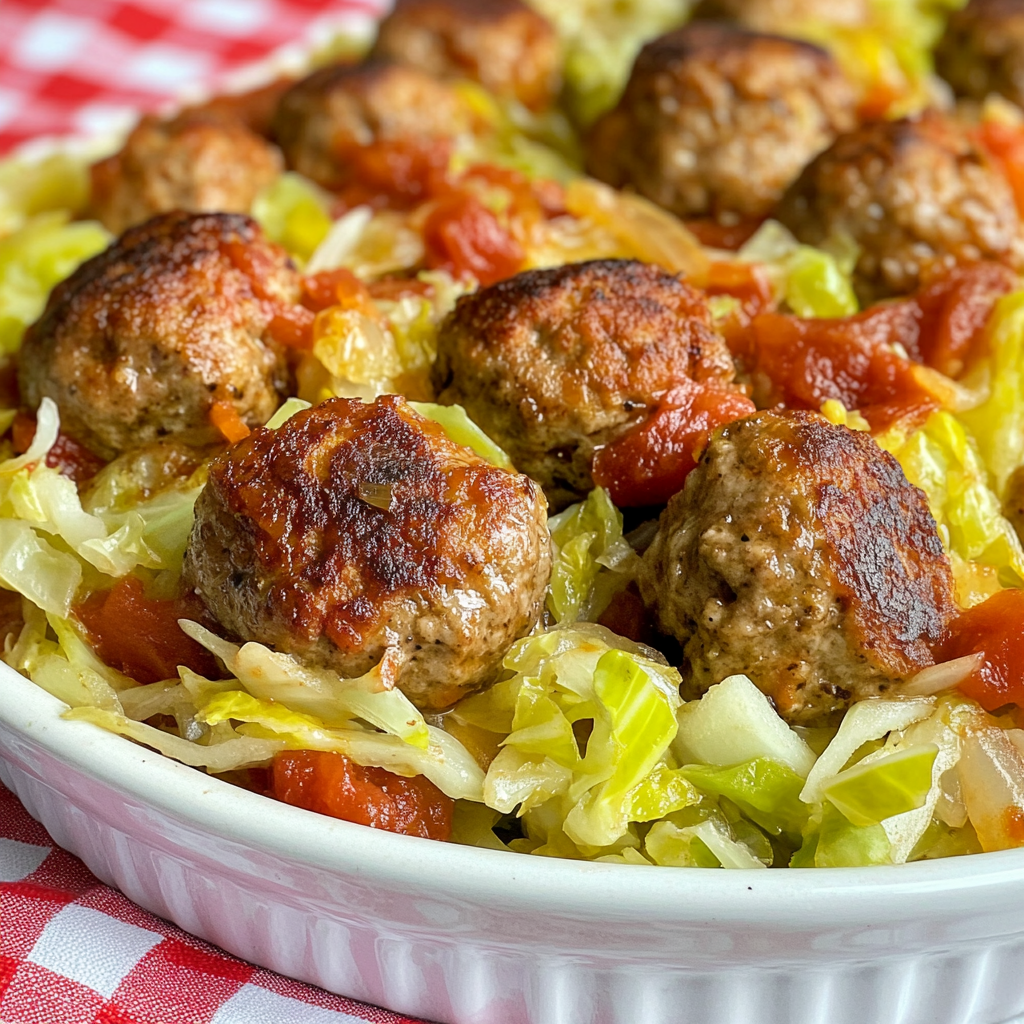Porcupine Meatballs with Cabbage

Share
This comforting dish combines tender porcupine meatballs—ground beef and rice meatballs that resemble porcupines as the rice pokes out during cooking—with a flavorful bed of sautéed cabbage. The cabbage adds a delightful texture and enhances the meal's nutritional value.
Did You Know?
Porcupine meatballs originated during the Great Depression as an economical way to stretch ground meat by adding rice. Incorporating cabbage not only boosts the dish's volume but also infuses it with vitamins and fiber, making it a wholesome family meal.
Yield
4 servings
Ingredients
For the Meatballs
1 pound ground beef
1/2 cup uncooked long-grain white rice
1/4 cup finely chopped onion
1 large egg, lightly beaten
1 teaspoon salt
1/2 teaspoon black pepper
1/2 teaspoon garlic powder
1/2 teaspoon paprika
For the Cabbage Base
1 tablespoon olive oil
1 medium head of cabbage, cored and thinly sliced
1 medium onion, thinly sliced
2 cloves garlic, minced
Salt and pepper to taste
For the Tomato Sauce
1 can (15 ounces) tomato sauce
1 cup beef broth
1 tablespoon Worcestershire sauce
1 teaspoon dried Italian seasoning
Salt and pepper to taste
Instructions
-
Prepare the Meatballs:
In a large bowl, combine ground beef, uncooked rice, chopped onion, beaten egg, salt, pepper, garlic powder, and paprika. Mix until well combined. Shape the mixture into 1 1/2-inch meatballs (about 12-14 meatballs). -
Sauté the Cabbage Base:
In a large skillet or Dutch oven, heat olive oil over medium heat. Add sliced onion and cook until translucent, about 3 minutes. Add minced garlic and cook for an additional minute. Stir in the sliced cabbage, season with salt and pepper, and cook until the cabbage is slightly wilted, about 5 minutes. -
Prepare the Tomato Sauce:
In a bowl, whisk together tomato sauce, beef broth, Worcestershire sauce, Italian seasoning, salt, and pepper. -
Assemble the Dish:
Place the prepared meatballs on top of the sautéed cabbage in the skillet. Pour the tomato sauce mixture over the meatballs and cabbage, ensuring the meatballs are mostly submerged in the sauce. -
Simmer:
Bring the mixture to a gentle boil over medium heat. Reduce heat to low, cover, and let it simmer for 45 minutes, or until the meatballs are cooked through and the rice is tender. Stir occasionally to prevent sticking. -
Serve:
Spoon the cabbage and sauce onto plates, top with meatballs, and enjoy!
Nutritional Information (Per Serving)
Calories: 350, Protein: 25g, Carbohydrates: 30g, Fiber: 5g, Net Carbohydrates: 25g, Fat: 15g, Saturated Fat: 5g, Cholesterol: 80mg, Sodium: 800mg, Sugars: 8g, Glycemic Index: Medium
Kitchen Tips, Great Ideas, How to Save Money
-
Use Lean Ground Beef: Opt for lean ground beef to reduce fat content without sacrificing flavor.
-
Add Vegetables: Incorporate finely chopped carrots or bell peppers into the meatball mixture for added nutrients.
-
Substitute Brown Rice: For a healthier option, use brown rice, but pre-cook it slightly as it takes longer to soften.
-
Make Ahead: Prepare meatballs in advance and freeze them. Thaw before cooking with the cabbage and sauce.
-
Use Homemade Broth: If available, homemade beef broth enhances the dish's flavor.
-
Adjust Seasonings: Feel free to modify the spices to suit your taste preferences.
-
Serve with Bread: Pair with crusty bread to soak up the delicious sauce.
-
Double the Recipe: This dish freezes well, so consider making a double batch for future meals.
-
Add Fresh Herbs: Garnish with fresh parsley or dill for a burst of freshness.
-
Use a Slow Cooker: After sautéing the cabbage, transfer all ingredients to a slow cooker and cook on low for 6-7 hours.
Let's Learn About Cabbage
Cabbage is a versatile vegetable rich in vitamins C and K, fiber, and antioxidants. It's low in calories and can be enjoyed raw in salads, fermented as sauerkraut, or cooked in various dishes. Its mild flavor allows it to absorb the tastes of accompanying ingredients, making it a staple in many cuisines worldwide.


